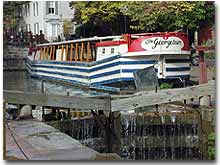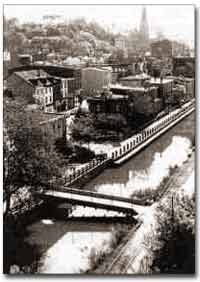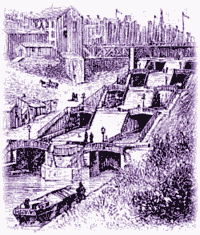25a. The Canal Era

Tourist boats like the Georgetown still run on sections of the Chesapeake and Ohio Canal in Washington, D.C.
Ever since the days of Jamestown and Plymouth, America was moving West. Trail blazers had first hewn their way on foot and by horseback. Homesteaders followed by wagon and by either keelboat or bargeboat, bringing their possessions with them. Yet, real growth in the movement of people and goods west started with the canal.
For over a hundred years, people had dreamed of building a canal across New York that would connect the Great Lakes to the Hudson River to New York City and the Atlantic Ocean. After unsuccessfully seeking federal government assistance, DeWitt Clinton successfully petitioned the New York State legislature to build the canal and bring that dream to reality. "Clinton's Ditch," his critics called it.

Canals like this one meandered across the Pennsylvania landscape in the 1800s. Some, like this one in the Manayunk section of Philadelphia, were operational into the 20th century.
Construction began in 1817 and was completed in 1825. The canal spanned 350 miles between the Great Lakes and the Hudson River and was an immediate success. Between its completion and its closure in 1882, it returned over $121 million in revenues on an original cost of $7 million. Its success led to the great Canal Age. By bringing the Great Lakes within reach of a metropolitan market, the Erie Canal opened up the unsettled northern regions of Ohio, Indiana and Illinois. It also fostered the development of many small industrial companies, whose products were used in the construction and operation of the canal.
New York City became the principal gateway to the West and financial center for the nation. The Erie Canal was also in part responsible for the creation of strong bonds between the new western territories and the northern states. Soon the flat lands of the west would be converted into large-scale grain farming. The Canal enabled the farmers to send their goods to New England. Subsistence farmers in the north were now less necessary. Many farmers left for jobs in the factories. The Erie Canal transformed America.

Pennsylvanians were shocked to find that the cheapest route to Pittsburgh was by way of New York City, up the Hudson River, across New York by the Erie Canal to the Great Lakes — with a short overland trip to Pittsburgh. When it became evident that little help for state improvements could be expected from the federal government, other states followed New York in constructing canals. Ohio built a canal in 1834 to link the Great Lakes with the Mississippi Valley. As a result of Ohio's investment, Cleveland rose from a frontier village to a Great Lakes port by 1850. Cincinnati could now send food products down the Ohio and Mississippi by flatboat and steamboat and ship flour by canal boat to New York.
The state of Pennsylvania then put through a great portage canal system to Pittsburgh. It used a series of inclined planes and stationary steam engines to transport canal boats up and over the Alleghenies on rails. At its peak, Pennsylvania had almost a thousand miles of canals in operation. By the 1830s, the country had a complete water route from New York City to New Orleans. By 1840, over 3,000 miles of canals had been built. Yet, within twenty years a new mode of transportation, the railroad, would render most of them unprofitable.






